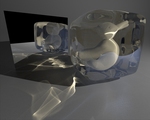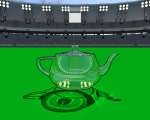Bachelor Thesis
2013/02/18 |
Tracking of Mesoscale Eddies in the Agulhas Current in Different Spatial and Temporal Resolutions |
Master Thesis
2014/09/22 |
Hierarchical Global Illumination by Using Cone Casts
Casting rays is a very common elementary operation in light simulation methods. We replace rays by cones to estimate a level of detail in a hierarchically represented scene.
This enables us to use only a part of the scene hierarchy to compute a full global illumination. Hence the performance and memory footprint become prop ortional to the image resolution and the metho d can b e used to render large out-of-core scenes.
In contrast to former cone casting methods we do not try to find an intersection between a cone and the scene. Instead we only trace the central ray and sample the cone interior sto chastically. This simplifies the intersection problem to rays where we use the cone radius for the level of detail estimation only. Whereas, reducing the radius towards zero leads to a standard ray tracing. Therefore it is possible to trade off correctness against performance.
Further we exploit the discretization of the scene to store intermediate results of diffuse illumination to increase the profit from recursive ray tracings. A novel light distribution pass also stores illumination directly, but generates artifacts yet.
Unsolved problems are a reliable reflection distribution for clustered scene geometry and the generation of caustics in the view-importance reduced scene. |
I3D 2016
 |
Precomputed Illuminance Composition for Real-time Global Illumination
Real-time global illumination method with unlimited bounces on diffuse and slightly glossy surfaces.
It relies on caches and fixed number of precomputed light transport paths towards a hierarchical discretization of the scene.
|
|
@inproceedings{Jendersie_Kuri_Grosch_i3d16_PICRGI, author = {Jendersie, Johannes and Kuri, David and Grosch, Thorsten}, title = {{Precomputed} {Illuminance} {Composition} for {Real-time} {Global} {Illumination}}, booktitle = {In Proc. ACM SIGGRAPH Symposium on Interactive 3D Graphics and Games (I3D)}, year = {2016}, month = feb, pages = {129--137}, publisher = {ACM}, keywords = {caches, global illumination, real-time, spherical harmonics, surfels} } |
|
JCGT 2016
[JCGT page]
 |
Real-Time Global Illumination Using Precomputed Illuminance Composition with Chrominance Compression
Extended journal version of "Precomputed Illuminance Composition for Real-time Global Illumination" which adds a compression of colors in SH caches to improve glossy surfaces.
|
|
@article{Jendersie_jcgt16_RTGI, author = {Johannes Jendersie and David Kuri and Thorsten Grosch}, title = {{Real-Time} {Global} {Illumination} {Using} {Precomputed} {Illuminance} {Composition} with {Chrominance} {Compression}}, year = 2016, month = {December}, journal = {Journal of Computer Graphics Techniques (JCGT)}, volume = 5, number = 4, pages = {8--35}, url = {http://jcgt.org/published/0005/04/02/}, issn = {2331-7418} } |
|
VMV 2017
 |
Pixel Cache Light Tracing
Extremly lightwight GPU-based Monte-Carlo global illumination method. It mixes light tracing (reprojection) with photon mapping without multiple importance sampling (which makes it lightweight). One of the most interesting points might be the lock-free hash-grid for the photon queries which only requires a few lines of GLSL.
|
|
@inproceedings{Jendersie_VMV17_PCLT, author = {Johannes Jendersie and Kai Rohmer and Felix Br{\"u}ll and Thorsten Grosch}, title = {{Pixel} {Cache} {Light} {Tracing}}, booktitle = {Proc. of Vision, Modeling and Visualization (VMV)}, year = {2017}, pages = {137--144}, doi = {10.2312/VMV.20171269}, } |
|
ISMAR 2017
 |
Natural Environment Illumination: Coherent Interactive Augmented Reality for Mobile and non-Mobile Devices
AR project with 3D-HDR environment reconstruction and a GPU-based Monte-Carlo illumination.
|
|
@article{Rohmer_ISMAR17_NatEnv, author = {Rohmer, Kai and Jendersie, Johannes and Grosch, Thorsten}, journal = {IEEE Transactions on Visualization and Computer Graphics (Proc. ISMAR)}, title = {{Natural Environment Illumination: Coherent Interactive Augmented Reality for Mobile and non-Mobile Devices}}, year = {2017}, volume = {23}, number = {11}, pages = {2474-2484}, doi = {10.1109/TVCG.2017.2734426}, keywords={Augmented Reality, Mixed Reality, Differential Rendering, Color Compensation, Impostors Tracing, GPU-Importance Sampling, Mobile AR, Scene Reconstruction, Light Estimation, Material Estimation, Depth-Sensing, Point Clouds, Global Illumination}, } |
|
ArXiv 2018
[ArXiv page]
 |
Path Throughput Importance Weights
An alternative perspective on MIS computations for paths in BPT and VCM.
|
|
@techreport{jendersie_path_2018, title = {Path {Throughput} {Importance} {Weights}}, url = {https://arxiv.org/abs/1806.01005}, number = {arXiv:1806.01005}, author = {Jendersie, Johannes}, month = jun, year = {2018} } |
|
EGSR 2018
[Supplemental]
 |
An Improved Multiple Importance Sampling Heuristic for Density Estimates in Light Transport Simulations
This paper shows that correlation of reused paths can cause invalid decisions for merge weights in multiple importance sampling. It proposes a robust heuristic to circumvent this problem.
|
|
@inproceedings{jendersie_improved_2018, title = {An {Improved} {Multiple} {Importance} {Sampling} {Heuristic} for {Density} {Estimates} in {Light} {Transport} {Simulations}}, booktitle = {Proc. of {Eurographics} {Symposium} on {Rendering} {EI}\&{I} {Track} ({EGSR})}, pages = {65--72}, publisher = {Eurographics Association}, author = {Jendersie, Johannes and Grosch, Thorsten}, month = jul, year = {2018}, DOI = {10.2312/sre.20181173} } |
|
Ray Tracing Gems
[RTG page]

|
Variance Reduction via Footprint Estimation in the Presence of Path Reuse
A revisited perspective and solution on the variance problem in merge multiple importance sampling weights.
Opposed to "An Improved Multiple Importance Sampling Heuristic for Density Estimates in Light Transport Simulations" above, the new heuristic proposed here is more robust, faster and needs much less additional memory.
|
|
@incollection{jendersie_variance_2019, title = {Variance Reduction via Footprint Estimation in the Presence of Path Reuse}, edition = {1}, volume = {1}, url = {http://raytracinggems.com}, pages = {557--569}, booktitle = {Ray Tracing Gems}, publisher = {Apress}, author = {Jendersie, Johannes}, editor = {Haines, Eric and Akenine-M{\"o}ller, Tomas}, date = {2019-02} } |
|
EGSR 2019
[Supplemental]
[Presentation]

|
Microfacet Model Regularization for Robust Light Transport
Highly glossy paths like caustics, SDS paths and near specular paths cause severe noise in almost any Monte Carlo simulation are not sampled at all.
A solution is to blur the materials such that they become more diffuse, which reduces the variance. Here, we show how to apply regularization (the blurring) to microfacet models and evaluate the consequences. For once, the MIS weight computation must be changed to fit the regularization process. Furthermore, we propose two heuristics to restrict the introduced bias to only those situations which would not be sampled otherwise.
|
|
@article{jendersie_brdfregularization_2019, author = {Jendersie, Johannes and Grosch, Thorsten}, title = {Microfacet {Model} {Regularization} for {Robust} {Light} {Transport}}, journal = {Computer {Graphics} {Forum} (Proc. of EGSR)}, volume = 38, number = 4, pages = {39--47}, publisher = {Eurographics Association}, month = jul, year = {2019}, DOI = {10.1111/cgf.13768} } |
|
ArXiv 2019
[ArXiv page]
 |
Next Event Backtracking
The quality of caustics degenerates over large distances, because only a small part of the traced photons hits the target region. This paper shows how to use the connection segment of a next event estimation as the first segment of a photon path. This greatly improves the caustic quality for far distant light sources.
However, next event backtracking is not strong enough as a stand alone estimator. In situations where the caustic throwing object is much closer to the light than to the receiver NEB is weak. General guidance methods and the addition of photons emitted from the lights directly can improve quality there.
Note: the version here is less compressed and contains an additional figure compared to the ArXiv version.
|
|
@techreport{jendersie_neb_2019, title = {Next {Event} {Backtracking}}, url = {https://arxiv.org/abs/1909.00573}, number = {arXiv:1909.00573}, author = {Jendersie, Johannes}, month = sep, year = {2019} } |
|
Report 2017

[Supplemental Formulas]
[Supplemetal Images]
|
Spherical Function Representations
A summary of plenty different possibilities to store data on a sphere.
This document presents 8 grid based approaches, 5 polynomial basis, mixture models and more.
As a general guideline I found that mixture models are far superior to the other models with respect to compression ratio.
However, they are also most difficult to handle and more expensive than most grids with a constant access time.
This is one of my very early research works, which never got published.
After it got rejected the first time, I never found the time to incorporate the reviewer's critics.
This is still the original document as in the first submission.
|
|
@techreport{jendersie_spheres_2017, title = {Spherical {Function} {Representations:} a {Practical} {Survey}}, number = {1}, author = {Jendersie, Johannes}, month = jul, year = {2017} } |
|










